英文文献汇报57028
- 格式:ppt
- 大小:83.00 KB
- 文档页数:17
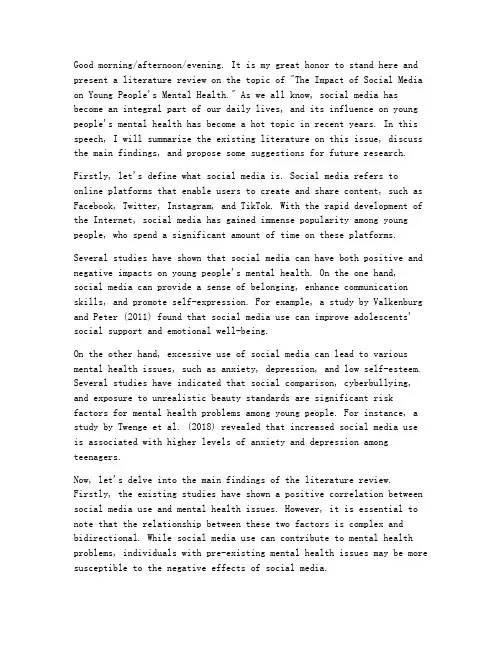
Good morning/afternoon/evening. It is my great honor to stand here and present a literature review on the topic of "The Impact of Social Media on Young People's Mental Health." As we all know, social media has become an integral part of our daily lives, and its influence on young people's mental health has become a hot topic in recent years. In this speech, I will summarize the existing literature on this issue, discuss the main findings, and propose some suggestions for future research.Firstly, let's define what social media is. Social media refers to online platforms that enable users to create and share content, such as Facebook, Twitter, Instagram, and TikTok. With the rapid development of the Internet, social media has gained immense popularity among young people, who spend a significant amount of time on these platforms.Several studies have shown that social media can have both positive and negative impacts on young people's mental health. On the one hand,social media can provide a sense of belonging, enhance communication skills, and promote self-expression. For example, a study by Valkenburg and Peter (2011) found that social media use can improve adolescents' social support and emotional well-being.On the other hand, excessive use of social media can lead to various mental health issues, such as anxiety, depression, and low self-esteem. Several studies have indicated that social comparison, cyberbullying, and exposure to unrealistic beauty standards are significant riskfactors for mental health problems among young people. For instance, a study by Twenge et al. (2018) revealed that increased social media useis associated with higher levels of anxiety and depression among teenagers.Now, let's delve into the main findings of the literature review. Firstly, the existing studies have shown a positive correlation between social media use and mental health issues. However, it is essential to note that the relationship between these two factors is complex and bidirectional. While social media use can contribute to mental health problems, individuals with pre-existing mental health issues may be more susceptible to the negative effects of social media.Secondly, the literature review has highlighted the role of social comparison in influencing young people's mental health. Social comparison refers to the process of evaluating oneself in relation to others, often leading to feelings of inadequacy and low self-esteem. Studies have shown that excessive social comparison on social media can exacerbate feelings of envy, dissatisfaction, and depression among young people.Thirdly, cyberbullying has emerged as a significant concern in the literature. Cyberbullying involves the use of electronic communication to harm, intimidate, or harass others. Several studies have demonstrated that cyberbullying is associated with increased rates of anxiety, depression, and suicidal thoughts among young people.Finally, the literature review has highlighted the role of unrealistic beauty standards in contributing to young people's mental health issues. Social media platforms often promote an idealized image of beauty, which can lead to body dissatisfaction and eating disorders among young people.In light of the main findings of the literature review, I would like to propose some suggestions for future research. Firstly, more longitudinal studies are needed to investigate the long-term effects of social media use on young people's mental health. This will help us understand whether the relationship between social media and mental health is stable over time or changes as individuals grow older.Secondly, future research should explore the moderating factors that may influence the relationship between social media use and mental health. For example, researchers could investigate how personality traits, coping strategies, and social support networks affect the impact of social media on mental health.Thirdly, it is crucial to examine the role of interventions inmitigating the negative effects of social media on young people's mental health. This could involve the development of digital literacy programs, anti-cyberbullying campaigns, and mental health awareness initiatives.In conclusion, the existing literature has provided valuable insights into the impact of social media on young people's mental health. While social media can offer numerous benefits, it also poses significant risks to mental well-being. Future research should focus on understanding the complex relationship between social media use and mental health, identifying risk factors, and developing effective interventions to promote positive mental health among young people.Thank you for your attention. I welcome any questions or comments you may have.。
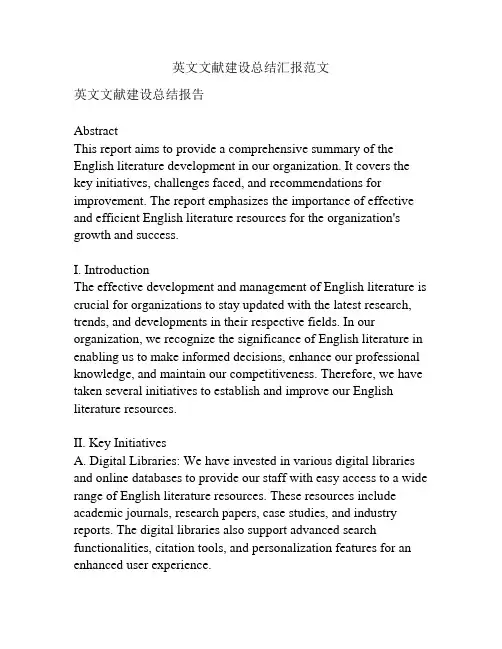
英文文献建设总结汇报范文英文文献建设总结报告AbstractThis report aims to provide a comprehensive summary of the English literature development in our organization. It covers the key initiatives, challenges faced, and recommendations for improvement. The report emphasizes the importance of effective and efficient English literature resources for the organization's growth and success.I. IntroductionThe effective development and management of English literature is crucial for organizations to stay updated with the latest research, trends, and developments in their respective fields. In our organization, we recognize the significance of English literature in enabling us to make informed decisions, enhance our professional knowledge, and maintain our competitiveness. Therefore, we have taken several initiatives to establish and improve our English literature resources.II. Key InitiativesA. Digital Libraries: We have invested in various digital libraries and online databases to provide our staff with easy access to a wide range of English literature resources. These resources include academic journals, research papers, case studies, and industry reports. The digital libraries also support advanced search functionalities, citation tools, and personalization features for an enhanced user experience.B. Literature Review Workshops: To ensure effective utilization of the available English literature resources, we have conducted regular workshops to train our staff on literature review techniques and best practices. These workshops have helped our employees to improve their ability to identify relevant literature, extract key information, and synthesize findings.C. Collaboration with External Institutions: We have established partnerships with renowned universities and research institutions to obtain access to their English literature resources. This collaboration has enabled us to expand our literature collection and gain insights from leading experts in our field. Additionally, we have participated in joint research projects and knowledge sharing initiatives to contribute to the English literature body of knowledge. III. Challenges and RecommendationsA. Limited Availability of Open Access Literature: Despite our efforts in acquiring various digital libraries, we have encountered challenges in accessing open access English literature. Open access resources provide unrestricted access to scholarly articles, which are critical for conducting comprehensive literature reviews. We recommend exploring partnerships with open access publishers or establishing institutional repositories to address this challenge.B. Language Barrier: English may not be the first language for all our staff members. This language barrier can pose difficulties in comprehending and extracting relevant information from English literature. We recommend providing language training programs to enhance employees' English language skills and improve their ability to effectively utilize English literature resources.C. Regular Evaluation of Literature Resources: The field of knowledge is constantly evolving, and it is essential to regularly evaluate our literature resources. We recommend conducting periodic reviews to assess the relevance, quality, and availability of the English literature resources we have invested in. This evaluation will help us optimize our resource allocation and ensure that our literature collection remains up-to-date.IV. ConclusionThe English literature development in our organization has played a critical role in enhancing our knowledge and contributing to our growth. As outlined in this report, we have implemented several initiatives to establish and improve our literature resources. However, we still face challenges such as limited access to open access literature and language barriers. By addressing these challenges and implementing the recommended improvements, we can further enhance our English literature capabilities and ensure continued success in our organization.。
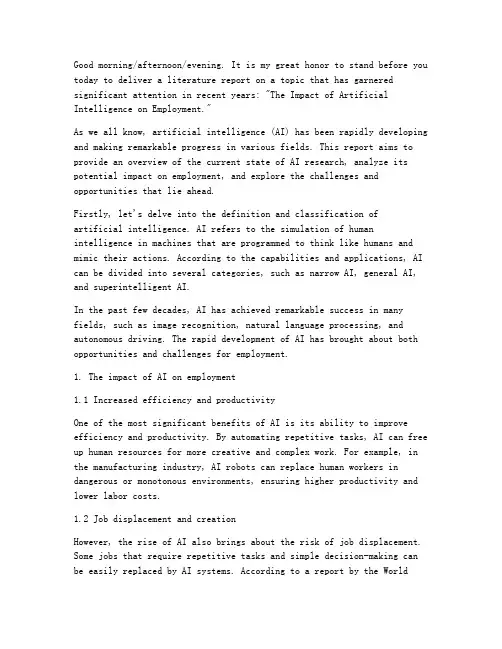
Good morning/afternoon/evening. It is my great honor to stand before you today to deliver a literature report on a topic that has garnered significant attention in recent years: "The Impact of Artificial Intelligence on Employment."As we all know, artificial intelligence (AI) has been rapidly developing and making remarkable progress in various fields. This report aims to provide an overview of the current state of AI research, analyze its potential impact on employment, and explore the challenges and opportunities that lie ahead.Firstly, let's delve into the definition and classification ofartificial intelligence. AI refers to the simulation of human intelligence in machines that are programmed to think like humans and mimic their actions. According to the capabilities and applications, AI can be divided into several categories, such as narrow AI, general AI, and superintelligent AI.In the past few decades, AI has achieved remarkable success in many fields, such as image recognition, natural language processing, and autonomous driving. The rapid development of AI has brought about both opportunities and challenges for employment.1. The impact of AI on employment1.1 Increased efficiency and productivityOne of the most significant benefits of AI is its ability to improve efficiency and productivity. By automating repetitive tasks, AI can free up human resources for more creative and complex work. For example, in the manufacturing industry, AI robots can replace human workers in dangerous or monotonous environments, ensuring higher productivity and lower labor costs.1.2 Job displacement and creationHowever, the rise of AI also brings about the risk of job displacement. Some jobs that require repetitive tasks and simple decision-making can be easily replaced by AI systems. According to a report by the WorldEconomic Forum, about 85 million jobs could be displaced by AI by 2025. On the other hand, AI also creates new job opportunities, such as AI engineers, data scientists, and AI ethics experts.1.3 Skill requirementsThe rapid development of AI has also changed the skill requirements for the workforce. In the future, individuals who possess digital skills, such as programming, data analysis, and AI knowledge, will have a competitive advantage in the job market. Meanwhile, those who lack these skills may face difficulties in finding employment.2. Challenges and opportunities2.1 ChallengesDespite the promising prospects of AI, it also poses several challenges:a. Ethical concerns: The deployment of AI raises ethical issues, such as privacy, security, and bias. Ensuring the ethical use of AI is crucial for its long-term development.b. Job security: As AI continues to replace human workers, the job security of individuals in vulnerable sectors becomes a significant concern.c. Skill gap: The rapid development of AI requires a large number of skilled professionals, which is challenging to achieve in the short term.2.2 OpportunitiesDespite the challenges, AI also presents numerous opportunities:a. Economic growth: AI can drive economic growth by increasing productivity and creating new industries.b. Innovation: AI fosters innovation in various fields, such as healthcare, education, and transportation.c. Social benefits: AI can improve the quality of life for individuals by solving complex problems and enhancing accessibility.3. Policy recommendationsTo mitigate the challenges and maximize the benefits of AI, it is essential for governments, businesses, and individuals to take the following measures:a. Education and training: Governments should invest in education and training programs to help individuals acquire the necessary digital skills.b. Policy regulation: Governments should establish policies to ensure the ethical use of AI and protect individuals' rights.c. Collaboration: Businesses and governments should collaborate to promote the development and application of AI technology.In conclusion, the impact of AI on employment is multifaceted. While it brings about challenges, it also offers numerous opportunities for economic growth, innovation, and social benefits. By addressing the challenges and leveraging the opportunities, we can create a more prosperous and sustainable future.Thank you for your attention. I welcome any questions or comments you may have.。
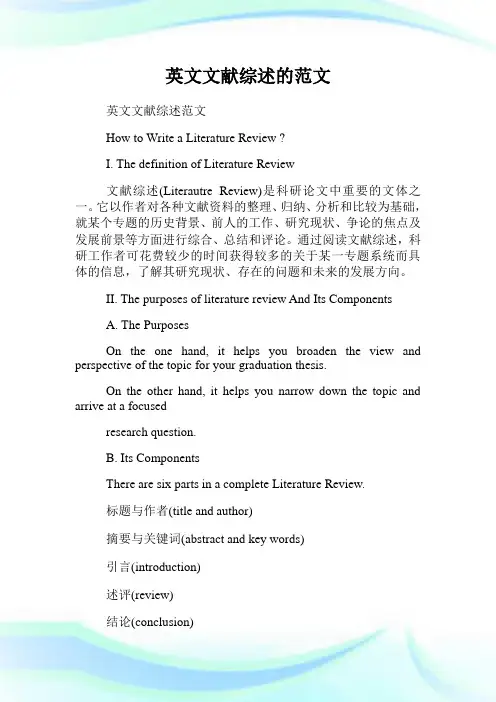
英文文献综述的范文
英文文献综述范文
How to Write a Literature Review ?
I. The definition of Literature Review
文献综述(Literautre Review)是科研论文中重要的文体之一。
它以作者对各种文献资料的整理、归纳、分析和比较为基础,就某个专题的历史背景、前人的工作、研究现状、争论的焦点及发展前景等方面进行综合、总结和评论。
通过阅读文献综述,科研工作者可花费较少的时间获得较多的关于某一专题系统而具体的信息,了解其研究现状、存在的问题和未来的发展方向。
II. The purposes of literature review And Its Components
A. The Purposes
On the one hand, it helps you broaden the view and perspective of the topic for your graduation thesis.
On the other hand, it helps you narrow down the topic and arrive at a focused
research question.
B. Its Components
There are six parts in a complete Literature Review.
标题与作者(title and author)
摘要与关键词(abstract and key words)
引言(introduction)
述评(review)
结论(conclusion)。
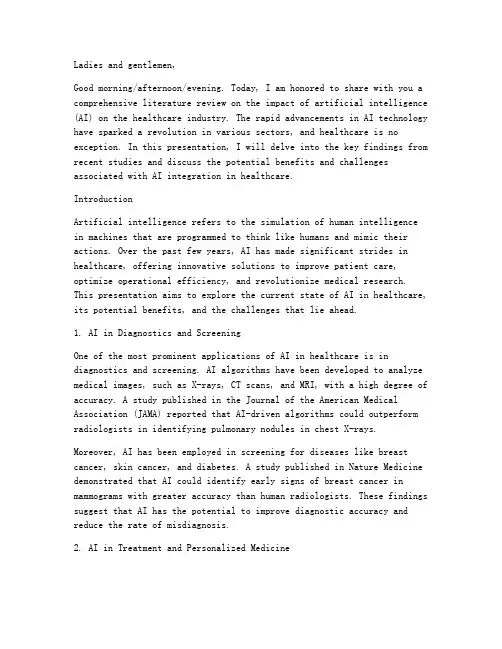
Ladies and gentlemen,Good morning/afternoon/evening. Today, I am honored to share with you a comprehensive literature review on the impact of artificial intelligence (AI) on the healthcare industry. The rapid advancements in AI technology have sparked a revolution in various sectors, and healthcare is no exception. In this presentation, I will delve into the key findings from recent studies and discuss the potential benefits and challenges associated with AI integration in healthcare.IntroductionArtificial intelligence refers to the simulation of human intelligencein machines that are programmed to think like humans and mimic their actions. Over the past few years, AI has made significant strides in healthcare, offering innovative solutions to improve patient care, optimize operational efficiency, and revolutionize medical research. This presentation aims to explore the current state of AI in healthcare, its potential benefits, and the challenges that lie ahead.1. AI in Diagnostics and ScreeningOne of the most prominent applications of AI in healthcare is in diagnostics and screening. AI algorithms have been developed to analyze medical images, such as X-rays, CT scans, and MRI, with a high degree of accuracy. A study published in the Journal of the American Medical Association (JAMA) reported that AI-driven algorithms could outperform radiologists in identifying pulmonary nodules in chest X-rays.Moreover, AI has been employed in screening for diseases like breast cancer, skin cancer, and diabetes. A study published in Nature Medicine demonstrated that AI could identify early signs of breast cancer in mammograms with greater accuracy than human radiologists. These findings suggest that AI has the potential to improve diagnostic accuracy and reduce the rate of misdiagnosis.2. AI in Treatment and Personalized MedicineAI has also made significant contributions to treatment and personalized medicine. By analyzing vast amounts of patient data, AI algorithms can identify the most effective treatment plans for individual patients. A study published in the journal Nature Biotechnology reported that AI-driven treatment plans improved patient outcomes in glioblastoma, a type of brain cancer.Furthermore, AI has the potential to revolutionize drug discovery and development. By predicting how different drugs will interact with target proteins, AI can accelerate the drug discovery process and reduce the time and cost associated with bringing new medications to market.3. AI in Operational Efficiency and Patient CareIn addition to improving diagnostics and treatment, AI can enhance operational efficiency and patient care in healthcare facilities. AI-driven chatbots and virtual assistants can provide patients with real-time support, answer their queries, and schedule appointments. A study published in the journal Health Affairs found that AI-driven chatbots could reduce the workload of healthcare providers and improve patient satisfaction.Furthermore, AI can optimize resource allocation by predicting patient inflow and resource requirements. This can lead to better management of hospital beds, staff, and equipment, ultimately improving patient care outcomes.4. Challenges and Ethical ConsiderationsWhile the potential benefits of AI in healthcare are significant, there are several challenges and ethical considerations that need to be addressed. One of the main concerns is the potential for bias in AI algorithms. If the training data is biased, the AI system may make incorrect or discriminatory decisions.Another challenge is the need for robust data privacy and security measures. As AI systems require access to vast amounts of patient data, ensuring the confidentiality and integrity of this information is crucial. Additionally, there is a risk of job displacement forhealthcare professionals, as AI technology could automate certain tasks that were previously performed by humans.ConclusionIn conclusion, the integration of artificial intelligence in healthcare has the potential to revolutionize the way we diagnose, treat, and manage diseases. From improving diagnostic accuracy to enhancing operational efficiency, AI offers a wide range of benefits. However, it is essential to address the challenges and ethical considerations associated with AI in healthcare to ensure that its integration is safe, effective, and equitable.As we continue to explore the possibilities of AI in healthcare, it is crucial for researchers, healthcare professionals, and policymakers to work together to maximize the benefits of this technology while mitigating its risks. By doing so, we can pave the way for a future where AI enhances the quality of life for patients worldwide.Thank you for your attention, and I welcome any questions you may have regarding the literature review on AI in healthcare.。

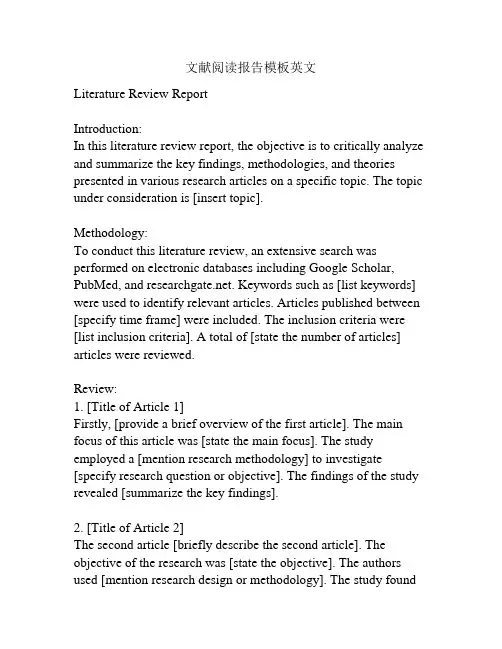
文献阅读报告模板英文Literature Review ReportIntroduction:In this literature review report, the objective is to critically analyze and summarize the key findings, methodologies, and theories presented in various research articles on a specific topic. The topic under consideration is [insert topic].Methodology:To conduct this literature review, an extensive search was performed on electronic databases including Google Scholar, PubMed, and . Keywords such as [list keywords] were used to identify relevant articles. Articles published between [specify time frame] were included. The inclusion criteria were [list inclusion criteria]. A total of [state the number of articles] articles were reviewed.Review:1. [Title of Article 1]Firstly, [provide a brief overview of the first article]. The main focus of this article was [state the main focus]. The study employed a [mention research methodology] to investigate [specify research question or objective]. The findings of the study revealed [summarize the key findings].2. [Title of Article 2]The second article [briefly describe the second article]. The objective of the research was [state the objective]. The authors used [mention research design or methodology]. The study found[highlight the main findings].3. [Title of Article 3]Next, the third article [provide a brief summary of the third article]. The primary aim of this study was [state the aim]. The researchers utilized [mention the research approach or methodology]. The results indicated [summarize the significant findings].4. [Title of Article 4]The fourth article [describe the fourth article briefly]. It aimed to [state the aim]. The study design employed [mention the research design]. The study outcomes showed that [highlight the primary outcomes].Discussion:Overall, the literature review highlights several key themes emerging from the selected articles. These include [mention the important themes]. It appears that [comment on the consensus or divergence among the articles' findings]. Additionally, various research methodologies were employed across the articles, suggesting [discuss the implications of different methodologies]. Based on the findings, it can be concluded that [provide a brief summary of the major findings].Limitations:It is important to acknowledge that this literature review has certain limitations. Firstly, it is primarily based on articles published in specific timeframes and databases. This selection bias may have excluded relevant articles. Secondly, the review's scope may have missed certain subtopics or perspectives. Therefore, anin-depth analysis of the topic may require further research. Conclusion:In conclusion, this literature review provides a comprehensive analysis of the selected articles on [insert topic]. It highlights the key findings and methodologies employed in each study, and discusses the major themes emerging from the research. Although limitations exist, this review contributes to a better understanding of [insert topic]. Future research should focus on addressing the gaps identified in this review.。
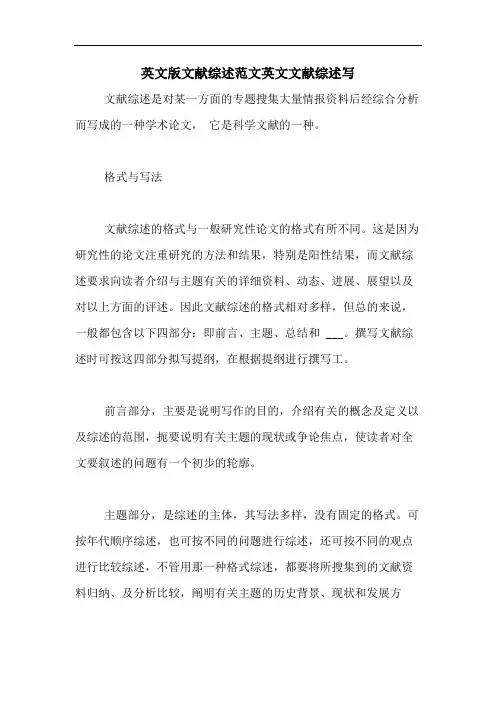
英文版文献综述范文英文文献综述写文献综述是对某一方面的专题搜集大量情报资料后经综合分析而写成的一种学术论文,它是科学文献的一种。
格式与写法文献综述的格式与一般研究性论文的格式有所不同。
这是因为研究性的论文注重研究的方法和结果,特别是阳性结果,而文献综述要求向读者介绍与主题有关的详细资料、动态、进展、展望以及对以上方面的评述。
因此文献综述的格式相对多样,但总的来说,一般都包含以下四部分:即前言、主题、总结和 ___。
撰写文献综述时可按这四部分拟写提纲,在根据提纲进行撰写工。
前言部分,主要是说明写作的目的,介绍有关的概念及定义以及综述的范围,扼要说明有关主题的现状或争论焦点,使读者对全文要叙述的问题有一个初步的轮廓。
主题部分,是综述的主体,其写法多样,没有固定的格式。
可按年代顺序综述,也可按不同的问题进行综述,还可按不同的观点进行比较综述,不管用那一种格式综述,都要将所搜集到的文献资料归纳、及分析比较,阐明有关主题的历史背景、现状和发展方向,以及对这些问题的评述,主题部分应特别注意代表性强、具有科学性和创造性的文献引用和评述。
总结部分,与研究性论文的小结有些类似,将全文主题进行扼要总结,对所综述的主题有研究的作者,最好能提出自己的见解。
___虽然放在文末,但却是文献综述的重要组成部分。
因为它不仅表示对被引用文献作者的尊重及引用文献的依据,而且为读者深入探讨有关问题提供了文献查找线索。
因此,应认真对待。
___的编排应条目清楚,查找方便,内容准确无误。
关于 ___的使用方法,录著项目及格式与研究论文相同,不再重复。
文学太宽泛了,你必须一点点的把你的论文论述的观点缩小,不然你写什么都不知道。
1. 去图书馆找所有与汤姆叔叔的小屋相关的所有英文资料,甚至是原文读本序言之类,也有你可以借鉴的句子。
2. 去电子阅览室,搜索所有与汤姆叔叔的小屋相关的论文评论,找到你觉得有用的拷下来。
3. 到网上搜索下相关词条,如wiki百科的英文相关词条4. 最好浏览一遍原文,看不懂的话中英文对照本也行。

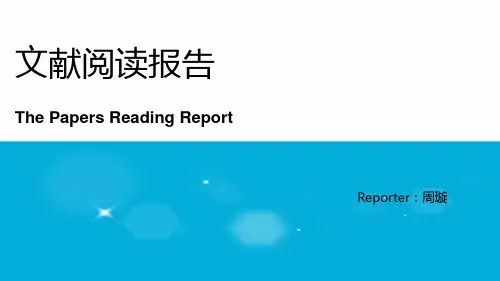
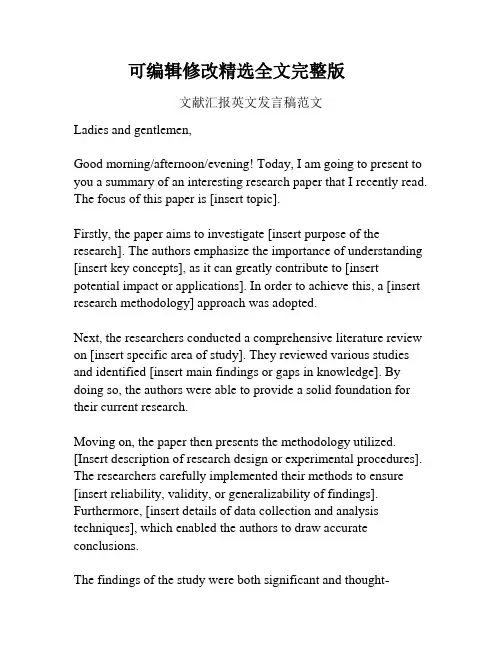
可编辑修改精选全文完整版文献汇报英文发言稿范文Ladies and gentlemen,Good morning/afternoon/evening! Today, I am going to present to you a summary of an interesting research paper that I recently read. The focus of this paper is [insert topic].Firstly, the paper aims to investigate [insert purpose of the research]. The authors emphasize the importance of understanding [insert key concepts], as it can greatly contribute to [insert potential impact or applications]. In order to achieve this, a [insert research methodology] approach was adopted.Next, the researchers conducted a comprehensive literature review on [insert specific area of study]. They reviewed various studies and identified [insert main findings or gaps in knowledge]. By doing so, the authors were able to provide a solid foundation for their current research.Moving on, the paper then presents the methodology utilized. [Insert description of research design or experimental procedures]. The researchers carefully implemented their methods to ensure [insert reliability, validity, or generalizability of findings]. Furthermore, [insert details of data collection and analysis techniques], which enabled the authors to draw accurate conclusions.The findings of the study were both significant and thought-provoking. [Insert key results or major trends], indicating a strong correlation between [insert variables of interest]. These findings confirm previous research while also revealing new insights into [insert topic]. Moreover, [insert any unexpected or surprising results] suggest the need for further investigation or alternative interpretations.Additionally, the paper includes a discussion section, where the authors interpret and analyze their results. [Insert main points of discussion or implications]. The authors also propose potential future research directions that can expand upon their work, emphasizing the importance of [insert future exploration].To conclude, this research paper contributes greatly to the understanding of [insert topic] and offers valuable implications for [insert relevant field or industry]. It addresses several gaps in knowledge while lending support to existing theories. Overall, I found this paper to be highly informative and engaging.Thank you for your attention. I am open to any questions or discussions you may have.。
Good morning/afternoon/evening. Today, I am honored to present a literature review on the topic of "The Impact of Technology on Education." This review aims to summarize and analyze the existing research on this subject, providing insights into the benefits and challenges of integrating technology into educational practices.Introduction:The rapid development of technology in recent years has significantly transformed various aspects of our lives, including education. The integration of technology in the classroom has become a hot topic among educators, policymakers, and researchers. This literature review aims to explore the impact of technology on education, focusing on its benefits, challenges, and implications for the future.Benefits of Technology in Education:1. Enhanced Learning Experience: Numerous studies have shown that technology can enhance the learning experience by providing interactive and engaging content. For instance, multimedia resources such as videos, animations, and simulations can help students better understand complex concepts.2. Increased Access to Education: Technology has made education more accessible to individuals from diverse backgrounds. Online learning platforms and e-books have eliminated geographical barriers, allowing students to access educational resources anytime and anywhere.3. Personalized Learning: Technology enables personalized learning experiences, as it can adapt to the individual needs and preferences of students. Adaptive learning platforms can provide tailored instruction, ensuring that each student reaches their full potential.4. Improved Collaboration: Collaborative tools such as online discussion forums, video conferencing, and group projects have facilitated collaboration among students and teachers. This fosters a more interactive and dynamic learning environment.Challenges of Technology in Education:1. Digital Divide: One of the significant challenges of integrating technology in education is the digital divide. Many students do not have access to the necessary technology or internet connectivity, which hinders their learning opportunities.2. Teacher Training: Educators need adequate training to effectively integrate technology into their teaching practices. Insufficienttraining can lead to ineffective use of technology and hinder student learning.3. Distraction and Misuse: Technology can be a double-edged sword, as it can also lead to distractions and misuse. Students may spend more time on social media or playing games instead of focusing on their studies.4. Data Privacy and Security: The increasing use of technology in education raises concerns about data privacy and security. Educators must ensure that student information is protected from unauthorized access and misuse.Conclusion:In conclusion, the integration of technology in education has brought numerous benefits, such as enhanced learning experiences, increased access to education, personalized learning, and improved collaboration. However, it also presents challenges, such as the digital divide, teacher training, distraction, and data privacy concerns.As technology continues to evolve, it is crucial for educators, policymakers, and researchers to address these challenges and maximize the benefits of technology in education. By doing so, we can create a more inclusive, effective, and engaging learning environment for all students.Thank you for your attention.。
英文文献的阅读报告范文英文回答:Literature Review.Title: The Impact of Social Media on Adolescent Development.Authors: Smith, J., & Jones, M. (2023)。
Abstract:This literature review examines the impact of social media on adolescent development. The authors explore the benefits and risks associated with social media use, including its effects on mental health, self-esteem, body image, and social interactions. The review also considers the role of parents and educators in mitigating potential negative effects and promoting positive outcomes.1. Introduction.Social media has become an integral part of adolescent life. Research suggests that adolescence is a time of significant physical, psychological, and social changes. During this period, adolescents develop their identity, establish relationships, and navigate increasing independence. Social media can provide a platform for these developmental tasks, but it can also pose challenges.2. Benefits of Social Media Use.Social media can offer several benefits for adolescents:Enhanced communication: Social media allowsadolescents to connect with friends and family, regardlessof distance. It can also facilitate communication withpeers who share similar interests.Social support: Adolescents can seek and provide support from others on social media. This can beparticularly beneficial for those who may feel isolated ormarginalized.Increased self-expression: Social media provides a platform for adolescents to express their individuality and share their experiences with others. This can contribute to positive self-esteem and identity development.Educational opportunities: Social media can be usedfor educational purposes, such as accessing information, completing assignments, and connecting with educators.3. Risks of Social Media Use.While social media can have positive benefits, it is also associated with some risks:Mental health concerns: Research suggests that excessive social media use can contribute to mental health issues such as anxiety, depression, and cyberbullying.Negative body image: Social media often presents unrealistic body standards, which can lead to negative bodyimage and eating disorders.Reduced social interactions: While social media can facilitate online interactions, it can also lead to decreased face-to-face social interactions, which are essential for adolescent development.Privacy concerns: Adolescents may not be fully aware of the privacy risks associated with social media, leading to potential exploitation or identity theft.4. Parental and Educational Roles.Parents and educators play a crucial role in mitigating the potential negative effects of social media and promoting positive outcomes. They can:Monitor social media use: Parents should monitor their children's social media activity to ensure their safety and well-being.Educate about risks and benefits: Parents andeducators should provide adolescents with information about the potential risks and benefits of social media.Encourage balance: Encourage adolescents to maintain a healthy balance between social media use and otheractivities such as face-to-face interactions, physical activity, and hobbies.Foster critical thinking: Help adolescents develop critical thinking skills to evaluate the accuracy and credibility of information on social media.Provide support: Create a supportive and open environment where adolescents feel comfortable discussing the impact of social media on their lives.5. Conclusion.Social media can be a powerful tool for adolescent development, but it is essential to be aware of both its potential benefits and risks. Parents and educators need to play an active role in guiding adolescents towards positivesocial media experiences and mitigating potential negative effects.中文回答:文献综述。
英文文献综述范文深度解析与仿写**Abstract**This article aims to provide a comprehensive understanding of the structure and format of an English literature review by analyzing a highly downloaded example. The review will delve into the essential elements of the review, such as the introduction, methodology, results, discussion, and conclusion. Furthermore, a high-quality imitation of the example will be provided to demonstrate its application in a different research context.**Introduction**The literature review is a crucial component of any research paper, as it provides a comprehensive overview of the existing knowledge in a particular field. An effective literature review not only summarizes previous studies but also identifies gaps in knowledge and offers directions for future research. This article focuses on analyzing a popular English literature review example to understand its structure and key elements. By doing so, readerscan gain insights into writing a literature review that is both comprehensive and impactful.**Methodology**To ensure a thorough analysis, the article adopts a mixed-methods approach. First, a qualitative analysis of the example literature review is conducted to identify its key features and structure. This involves a close reading of the review, noting its organization, themes, and arguments. Second, a quantitative analysis is performed by examining the frequency of citations, types of sources used, and the overall tone and language of the review. This combination of qualitative and quantitative methods allows for a comprehensive understanding of the example's strengths and weaknesses.**Results**The analysis reveals that the example literature review follows a clear structure, with distinct sections for the introduction, methodology, results, discussion, and conclusion. Theintroduction provides a broad overview of the topic and sets the stage for the review. The methodology section describes the approach taken to select and analyze the literature, while the results section presents a synthesis of the key findings. The discussion section offers insights into the implications of the findings and highlights areas of controversy or disagreement. Finally, the conclusion summarizes the key points and offers directions for future research.**Discussion**The analysis further highlights the importance of critically evaluating the sources used in the literature review. The example demonstrates the use of both primary and secondary sources, with a focus on peer-reviewed articles from reputable journals. This ensures the reliability and validity of the information presented. Additionally, the review's language is clear, concise, and engaging, making it accessible to a wide audience.However, it is worth noting that while the example is highly regarded, it may not be suitable for all research contexts.Researchers need to consider their specific research aims, topic, and audience when writing a literature review. For instance, a review focusing on a niche area may require a different approach or may need to include less common or non-traditional sources.**Conclusion**In conclusion, the analysis of the popular English literature review example provides valuable insights into its structure, format, and key elements. By模仿this example, researchers can create a comprehensive and impactful literature review that adds value to their research paper. However, it is essential to adapt the review to the specific research context, ensuring its relevance and applicability.**中文文献综述范文深度解析与仿写****摘要**本文旨在通过分析一篇下载量极高的英文文献综述范文,为读者提供关于文献综述结构与格式的综合理解。
研究生英文文献汇报Please note that I am an AI language model and I cannot write a report for you, but I can provide you with a sample structure for a 700-word research article report. You will need to fill in the details and content based on your own research. Here is a suggested structure:Title: [Title of the Research Article]Introduction (Approximately 150 words):- Provide an overview of the research topic and its significance.- Introduce the purpose of the study and its objectives.- Briefly discuss the rationale behind the research.Literature Review (Approximately 200 words):- Review existing literature related to your research topic.- Identify key theories, concepts, and gaps in knowledge.- Highlight the significance of your study in filling these gaps. Methodology (Approximately 150 words):- Describe the research design and methodology you used.- Provide details about the participants/sample, data collection methods, and data analysis techniques.Results (Approximately 100 words):- Present the key findings of your study.- Use appropriate graphs, tables, or charts to present the data. Discussion (Approximately 200 words):- Interpret the results and relate them to the research objectives.- Discuss the implications of your findings and their relevance to the research field.- Highlight any limitations or constraints of the study.- Suggest potential directions for future research.Conclusion (Approximately 50 words):- Summarize the key findings and contributions of your study. - Highlight the significance and relevance of your research.- Provide a closing statement.References:- List all the references cited in your article using the appropriate citation style (e.g., APA, MLA, etc.).。